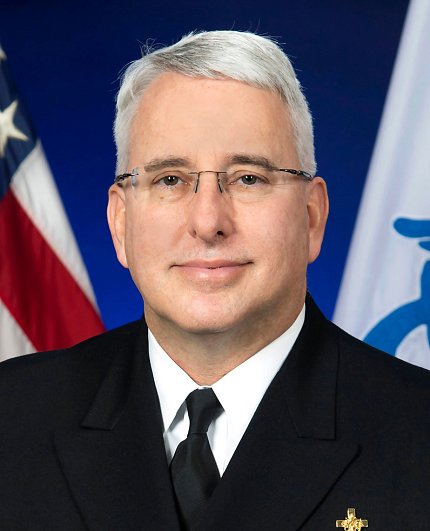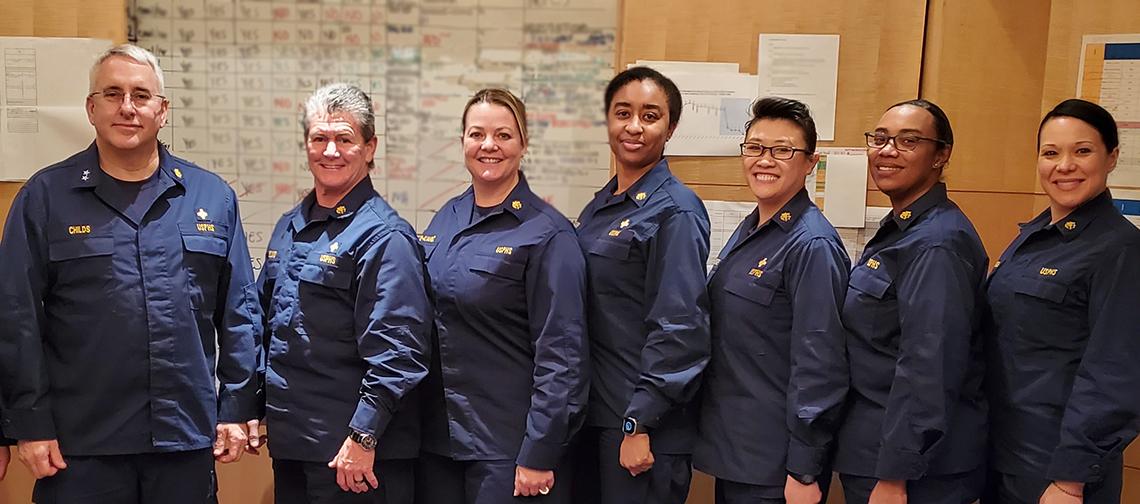NHLBI’s Childs on Front Lines of Covid-19 Health Crisis

In 2014, when the deadly Ebola virus was spreading like wildfire through parts of West Africa, Radm. Richard Childs led a team of physicians, nurses, engineers and safety inspectors to Monrovia, Liberia, to help treat the thousands of patients who had been infected. As chief medical officer for the Public Health Service Commissioned Corps’ Ebola Crisis Response, Childs worked steadily for more than 2 months, caring for sick Liberian health care workers, while the global community scurried to contain the virus.
That was then.
Six years later, Childs, now assistant U.S. surgeon general and clinical director of the National Heart, Lung and Blood Institute’s Division of Intramural Research, is back on the front lines of a new, even deadlier global health emergency—the coronavirus pandemic.
On Feb. 15, Childs led an international mission to evacuate hundreds of Americans from the Diamond Princess cruise ship off the coast of Japan and then care for 50 who had become infected with Covid-19, the disease caused by SARS-CoV-2. The cruise vessel had become a hotspot for the virus, with more than 700 passengers testing positive.

Photo: Richard Childs
What unfolded when they arrived, however, was nothing Childs could have predicted when he set out. It started with a chance encounter with a former colleague and ended with the successful treatment, using the antiviral drug remdesivir, on a few of the most critically ill Americans. Ten weeks later, the National Institute of Allergy and Infectious Diseases announced that remdesivir could be an effective aid in speeding recovery for some Covid-19 patients and potentially help in the survival of the most severely ill.
But when Childs, along with executive officer Cmdr. Julie Erb-Alvarez and 24 other PHS officers, touched down in Japan that February day, none of this was on their radar. He and his team, he said, had their sights set mainly on getting the Americans safely off the ship, then ensuring that those who were critically ill got immediate medical care. Childs said they worked alongside the U.S. Embassy in Japan and the Japanese Ministry of Health to track down the Americans who were admitted to about 25 different hospitals in and around Yokohama and Tokyo. They consulted with the Japanese physicians providing their care and made sure each facility had the medical capabilities required to adequately treat them.
As luck would have it, Childs then ran into a former colleague from NIH, Dr. Robert Walker, now deputy director of clinical studies at the Biomedical Advanced Research and Development Authority in Washington, D.C. Walker was in Japan working to establish an international randomized controlled trial for remdesivir, which had previously been tested in humans with the Ebola virus. The drug had shown to be a possible treatment for other coronaviruses such as severe acute respiratory syndrome (SARS) and Middle East respiratory syndrome (MERS). Now, scientists were hopeful it would stop or slow the virus from replicating long enough for the patient’s immune system to fight off the virus.
Through his contact with Walker, Childs said, he got enough remdesivir from the drug’s maker, Gilead Sciences, Inc., to treat 20 critically ill American and Japanese patients, using a compassionate-use protocol. He and his team then went to work reviewing the medical records of each patient to identify those with severe pneumonia who would be candidates. The need for a medical translator initially threatened to delay their work, until Childs recruited one of his former NHLBI postdoctoral fellows, Dr. Takehito Igarashi, who lives in Tokyo and works as an endocrine surgeon.
In reviewing the records, Childs said he quickly became disturbed by what he saw. Some patients were so sick they had a “complete whiteout” of their lungs on a chest X-ray, and he knew many were at high risk of dying.

Photo: Richard Childs
Ultimately, he and the PHS team identified 14 patients with severe pneumonia, including 10 who were on mechanical ventilators and 4 on so-called ECMO machines that function like the heart-lung bypass machines used during open-heart surgery. These critical patients were age 75 on average.
“Experience from China at the time showed only a minority of elderly patients with Covid-19 who were treated with mechanical ventilation or ECMO survived,” Childs said. “Nevertheless, Japanese intensivists pushed the envelope with aggressive supportive care in an effort to save every one of these critically ill patients.”
In the end, the PHS team was able to get remdesivir treatments to 9 critically ill patients—4 Americans and 5 Japanese.
Remarkably, all of them survived.
Now, Childs is looking even more broadly at the drug as a possible treatment for those with Covid-19.

Photo: Richard Childs
Since returning home, he co-authored an article in the New England Journal of Medicine highlighting preliminary results of the drug’s use in 53 patients, ages 23-82, who were hospitalized in the United States, Europe, Canada and Japan. Thirty-four were sick enough to require ventilation support. After receiving remdesivir, 68 percent of patients showed clinical improvement in their pneumonia symptoms—they needed less oxygen, for example—and 58 percent were weaned off ventilation support. Seven patients, all age 70 and older, died. At least 12 patients had serious problems, including septic shock and trouble with kidneys and other organs. These first preliminary published data suggested that remdesivir, when used under a compassionate-use protocol, may have clinical activity against SARS-CoV-2 and could potentially improve outcomes in patients with severe Covid-19.
Childs commended scientists and doctors everywhere who are researching a range of different treatments and an effective vaccine against Covid-19. “It’s not a matter of if we are going to beat the virus, but when,” he said.
Another NIH clinical trial has begun to evaluate the safety and efficacy of hydroxychloroquine as a potential treatment for hospitalized adults diagnosed with Covid-19. Randomized trials evaluating numerous other therapeutic approaches, including the use of convalescent plasma collected from patients who have recovered from the virus, are in the works.
For people around the globe, an effective treatment cannot come too soon. As of May 11, the World Health Organization had reported more than 4 million cases of Covid-19 and more than 278,000 deaths worldwide. And, more than 1.3 million confirmed cases and upwards of 79,000 deaths had been reported in the U.S., according to the Centers for Disease Control and Prevention.
Childs said he will continue to stay tuned to the public health needs presented by the virus. But the public must do its part to help dramatically slow its spread—something he said is not happening the way many scientists had hoped.
“It is hard not to get discouraged when you see people in public places not embracing preventive measures such as wearing masks and social distancing,” Childs said. “Unless everyone buys into these preventive measures, both at home and in the workplace, we’re just going to make this epidemic drag out longer, which will lead to continued new cases and preventable deaths.”
Since his return from Japan, Childs and his PHS team continue to follow up remotely with the patients from the Diamond Princess, a few of whom still remain in the hospital in Tokyo. Childs is currently working at Commissioned Corps Headquarters Command Center, where he is the commander for safety for hundreds of officers deployed to numerous federal medical stations (FMS) and alternate care sites across the U.S. The Javits Center FMS in New York City, where doctors cared for more than 1,000 Covid-19 patients, was among those Childs helped set up.
In the meantime, Childs continues in his role at NHLBI, where he oversees the clinical research activities of the intramural research division, which conducts first-in-human research in cardiology, vascular medicine, pulmonary medicine, hematology, population sciences, diagnostic imaging and now, Covid-19.
